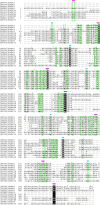Characteristics of the Kelch domain containing (KLHDC) subfamily and relationships with diseases
- PMID: 39887712
- PMCID: PMC12035522
- DOI: 10.1002/1873-3468.15108
Characteristics of the Kelch domain containing (KLHDC) subfamily and relationships with diseases
Abstract
The Kelch protein superfamily is an evolutionary conserved family containing 63 alternate protein coding members. The superfamily is split into three subfamilies: Kelch like (KLHL), Kelch-repeat and bric-a-bracs (BTB) domain containing (KBTBD) and Kelch domain containing protein (KLHDC). The KLHDC subfamily is one of the smallest within the Kelch superfamily, containing 10 primary members. There is little known about the structures and functions of the subfamily; however, they are thought to be involved in several cellular and molecular processes. Recently, there have been significant structural and biochemical advances for KLHDC2, which has aided our understanding of other KLHDC family members. Furthermore, small molecules directly targeting KLHDC2 have been identified, which act as tools for targeted protein degradation. This review utilises this information, in conjunction with a thorough exploration of the structural aspects and potential biological functions to summarise the relationship between KLHDCs and human disease.
Keywords: KLHDC; Kelch family; protein degradation; protein function.
© 2025 The Author(s). FEBS Letters published by John Wiley & Sons Ltd on behalf of Federation of European Biochemical Societies.
Figures





Similar articles
-
Molecular phylogeny of the kelch-repeat superfamily reveals an expansion of BTB/kelch proteins in animals.BMC Bioinformatics. 2003 Sep 17;4:42. doi: 10.1186/1471-2105-4-42. Epub 2003 Sep 17. BMC Bioinformatics. 2003. PMID: 13678422 Free PMC article.
-
Kelch proteins: emerging roles in skeletal muscle development and diseases.Skelet Muscle. 2014 Jun 1;4:11. doi: 10.1186/2044-5040-4-11. eCollection 2014. Skelet Muscle. 2014. PMID: 24959344 Free PMC article. Review.
-
Update on the Kelch-like (KLHL) gene family.Hum Genomics. 2013 May 15;7(1):13. doi: 10.1186/1479-7364-7-13. Hum Genomics. 2013. PMID: 23676014 Free PMC article.
-
The roles of KLHL family members in human cancers.Am J Cancer Res. 2022 Nov 15;12(11):5105-5139. eCollection 2022. Am J Cancer Res. 2022. PMID: 36504893 Free PMC article. Review.
-
A kelch motif-containing protein KLHDC2 regulates immune responses against Vibrio parahaemolyticus and white spot syndrome virus in Penaeus vannamei.Fish Shellfish Immunol. 2022 Aug;127:187-194. doi: 10.1016/j.fsi.2022.06.009. Epub 2022 Jun 16. Fish Shellfish Immunol. 2022. PMID: 35716970
Cited by
-
Targeted protein degradation by KLHDC2 ligands identified by high-throughput screening.Elife. 2025 Jun 16;14:RP106844. doi: 10.7554/eLife.106844. Elife. 2025. PMID: 40522120 Free PMC article.
-
Minute amounts of helicase-deficient truncated RECQL4 are sufficient for DNA replication.bioRxiv [Preprint]. 2025 Jul 21:2025.07.21.666025. doi: 10.1101/2025.07.21.666025. bioRxiv. 2025. PMID: 40777487 Free PMC article. Preprint.
-
LZTR1: c.1260+1del Variant as a Significant Predictor of Early-Age Breast Cancer Development: Case Report Combined with In Silico Analysis.Int J Mol Sci. 2025 Jul 12;26(14):6704. doi: 10.3390/ijms26146704. Int J Mol Sci. 2025. PMID: 40724954 Free PMC article.
References
-
- Adams J, Kelso R and Cooley L (2000) The Kelch repeat superfamily of proteins: propellers of cell function. Trends Cell Biol 10, 17–24. - PubMed
-
- Shi X, Xiang S, Cao J, Zhu H, Yang B, He Q and Ying M (2019) Kelch‐like proteins: physiological functions and relationships with diseases. Pharmacol Res 148, 104404. - PubMed
Publication types
MeSH terms
Grants and funding
LinkOut - more resources
Full Text Sources

